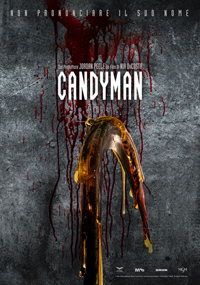Sweet Heat: DaCosta Resurrects a Darkness in Spiritual Sequel
 Back in 1991, Bernard Rose’s Candyman rose to prominence as one of the few mainstream American horror films to grapple with the virulence of racism, a normalized reality since the country’s original sin of slavery (and let’s not forget the prologue of colonialism which gutted and pillaged the country’s indigenous population). A sort of urban slice of folk horror, the power of Rose’s film is thanks to its rich, powerful subtexts, perhaps owing part of its success to Rose, a British director, himself a stranger to the narrative’s thrust. Told through the perspective of its white heroine, an outsider examining an ‘uncharted’ history of a disenfranchised community, its brilliance in solidifying an urban legend, as based on a short story by Clive Barker, demands an acknowledgment of racism and historical trauma infecting contemporary realities.
Back in 1991, Bernard Rose’s Candyman rose to prominence as one of the few mainstream American horror films to grapple with the virulence of racism, a normalized reality since the country’s original sin of slavery (and let’s not forget the prologue of colonialism which gutted and pillaged the country’s indigenous population). A sort of urban slice of folk horror, the power of Rose’s film is thanks to its rich, powerful subtexts, perhaps owing part of its success to Rose, a British director, himself a stranger to the narrative’s thrust. Told through the perspective of its white heroine, an outsider examining an ‘uncharted’ history of a disenfranchised community, its brilliance in solidifying an urban legend, as based on a short story by Clive Barker, demands an acknowledgment of racism and historical trauma infecting contemporary realities.
Thirty years later (in the interim there was Bill Condon’s 1995 sequel Candyman: Farewell to the Flesh and a direct-to-video third film in 1999), director Nia DaCosta takes the reigns in an examination of splinters, intersections and present-day tendencies for a more authentically administered perspective. A squirming ganglion of competing ideas foment simultaneously, compelling us to examine the past in a gentrified world, where evil returns through the fractured assimilation of artistic elitism while also conversing with Rose’s introductory chapter, creating a horror film filled with fascinating moments while stumbling over the patched framework of its own lore.
In the revamped climes of Chicago’s once-infamous Cabrini Green housing complex, gentrification has replaced the desperation with a glossy, chic urban sheen. Art curator Brianna Cartwright (Tayonah Parris) has moved into a beautiful new apartment with her boyfriend, Anthony McCoy (Yahya Abdul-Matteen II), a promising artist. Securing him a slot in an upcoming exhibition, Anthony struggles to create a piece worthy of the distinction. When Brianna’s brother Troy (Nathan Stewart-Jarrett) and his partner boyfriend (Kyle Kaminsky) visit, he shares a story about a white grad student named Helen, who, thirty years prior, was researching the legend of Candyman and lost her mind. Anthony is inspired by the tale, and creates an installation piece called “Say Your Name,” inviting the curious to invoke Candyman by uttering his name five times in the mirror. As mayhem ensues, so does Anthony embark on a perilous journey into darkness.
DaCosta begins her inverse approach before the opening credits arrive, the Universal and MGM logos presented as backwards reflections. The device of creepy shadow puppets bookend the credits, also appearing through the exposition of Colman Domingo’s William Burke, a Cabrini Green resident who experienced a traumatic scrape with Candyman. Burke supplies a curious connective tissue, exemplifying how historical trauma defines a trajectory of fate, or perhaps self-fulfilling prophecy. Like Parris’ Brianna, childhood tragedy has looped them into a cyclical pattern as adults, suggesting subconscious fate. How the past reflects on the present, and the distorted perspective of ‘looking backwards’ feeds into some brilliantly rippling subjects…and yet, these details are so compounded, DaCosta’s Candyman sometimes feels a little muddled, as if it needs to stop and take a breath.
Co-written by producer Jordan Peele and his “Twilight Zone” alum Win Rosenfeld, the various narrative segues beg for explication, particularly with Domingo’s Burke (who walks away with the best performance) and Vanessa Williams, playing the same character from the 1991 film. (On a side note, the film’s parameters play like the nightmare world version of 2020’s indie film Really Love directed by Angel Kristi Williams).
Parris, who previously starred in another potent Chicagoan narrative, Spike Lee’s Chi-raq (2016), takes center stage in the third act, but in doing so, robs the momentum of Matteen’s eerie transformation. An empathetic beat is missing concerning his fate. Instead, DaCosta volleys the narrative onto the trials of the Black woman as a resilient witness and steadfast messenger. Although some of its peripheral characters slide into caricature (Brian King’s pretentious gallery owner; Rebecca Spence’s art critic), Candyman bolsters an already robust mythos with formidable possibility, even though it feels like a film hellbent on stuffing all its ideas in one place, potentially to offset an inability to generate another sequel.
DP John Gulesarian manages to evoke the chilliness beneath the exterior of a city’s glossy overhaul, a direct juxtaposition to the grittiness of the first film. Impeccable sound design and a score from Robert A.A. Lowe assists in securing Candyman as a horror film of a pedigree which insists on being more than a meaningless cash grab or nostalgic hodgepodge (for nostalgia, like looking backward, is a certain kind of death). There’s more to examine here and we can certainly afford to say his name a couple more times.
★★★½/☆☆☆☆☆


